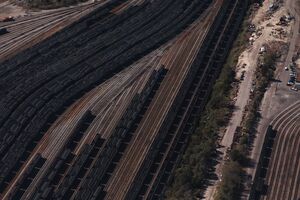Railcar Covers and Lids
One solution to fugitive coal dust emissions is to cover the train cars with a physical lid. To read more about other solutions, like wet suppression systems, go to: Chemical Dust Suppression: Sprinklers and Surfactants

Covered hopper cars, which are equipped with a roof, have historically been used for cargo like grain, sugar, and fertilizer, that must be protected from exposure to the weather. Coal, which can be exposed with minimal effect to the product, has been transported in open hopper cars. In an effort to prevent dangerous fugitive coal dust emissions, some railroads and coal shippers have begun putting covers on the coal as well. However, because of cheaper (and often more effective) solutions on the market, covering the coal remains a rare choice for dust control.
Dust Control
A 2004 experiment by Ferreira & Vaz found that the use of covers reduces the amount of dust released to be less than 20% of the quantity eroded from the uncovered wagon. In other words, when compared to the no-cover situation, the semi-cover reduced the dust amount released more than 80% for the full-load situation.[1]
Safety Concerns
Coal dust is highly combustible, and supposedly covering it up makes the risk of combustion significantly worse. This is among the reasons that railroad companies favor chemical dust suppressants over covering their coal hoppers.
Documents
Research Papers
- Ferreira, A.D., D.X. Viegas, and A.C.M. Sousa. 2003. “Full-Scale Measurements for Evaluation of Coal Dust Release from Train Wagons with Two Different Shelter Covers.” Journal of Wind Engineering and Industrial Aerodynamics 91 (10): 1271–83. https://doi.org/10.1016/s0167-6105(03)00077-1.
- Ferreira, A.D, and P.A Vaz. 2004. “Wind Tunnel Study of Coal Dust Release from Train Wagons.” Journal of Wind Engineering and Industrial Aerodynamics 92 (7-8): 565–77. https://doi.org/10.1016/j.jweia.2004.03.003.